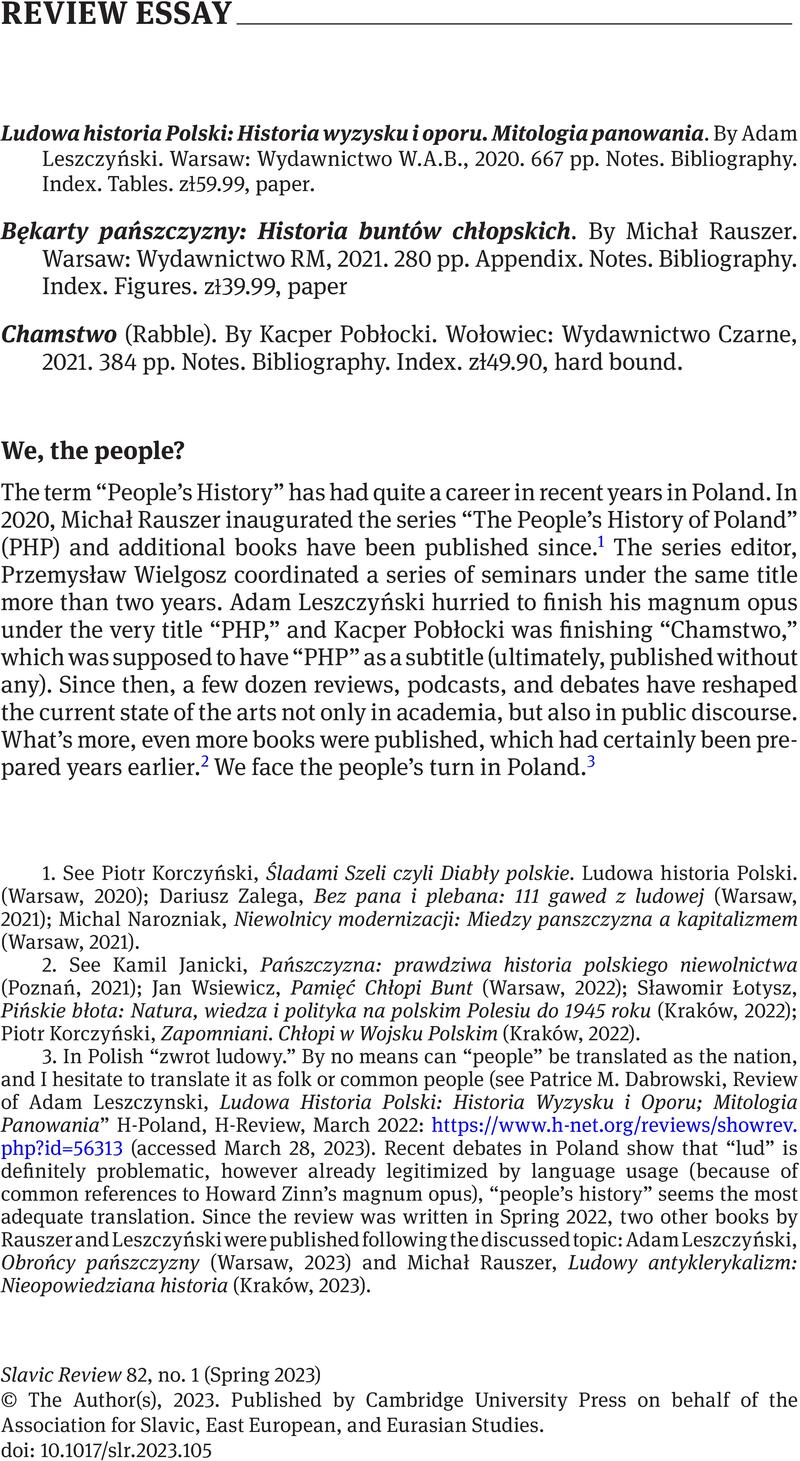Published online by Cambridge University Press: 03 August 2023

1. See Korczyński, Piotr, Śladami Szeli czyli Diabły polskie. Ludowa historia Polski. (Warsaw, 2020)Google Scholar; Zalega, Dariusz, Bez pana i plebana: 111 gawed z ludowej (Warsaw, 2021)Google Scholar; Narozniak, Michal, Niewolnicy modernizacji: Miedzy panszczyzna a kapitalizmem (Warsaw, 2021)Google Scholar.
2. See Janicki, Kamil, Pańszczyzna: prawdziwa historia polskiego niewolnictwa (Poznań, 2021)Google Scholar; Wsiewicz, Jan, Pamięć Chłopi Bunt (Warsaw, 2022)Google Scholar; Łotysz, Sławomir, Pińskie błota: Natura, wiedza i polityka na polskim Polesiu do 1945 roku (Kraków, 2022)Google Scholar; Korczyński, Piotr, Zapomniani. Chłopi w Wojsku Polskim (Kraków, 2022)Google Scholar.
3. In Polish “zwrot ludowy.” By no means can “people” be translated as the nation, and I hesitate to translate it as folk or common people (see Patrice M. Dabrowski, Review of Adam Leszczynski, Ludowa Historia Polski: Historia Wyzysku i Oporu; Mitologia Panowania” H-Poland, H-Review, March 2022: https://www.h-net.org/reviews/showrev.php?id=56313 (accessed March 28, 2023). Recent debates in Poland show that “lud” is definitely problematic, however already legitimized by language usage (because of common references to Howard Zinn's magnum opus), “people's history” seems the most adequate translation. Since the review was written in Spring 2022, two other books by Rauszer and Leszczyński were published following the discussed topic: Adam Leszczyński, Obrońcy pańszczyzny (Warsaw, 2023) and Michał Rauszer, Ludowy antyklerykalizm: Nieopowiedziana historia (Kraków, 2023).
4. See Gross, Jan Tomasz, Sa̜siedzi: Historia zagłady żydowskiego miasteczka; Pamie̜ci Szmula Wasersztajna (Sejny, 2000)Google Scholar; Sowa, Jan, Fantomowe cialo króla: Peryferyjne zmagania z nowoczesna forma (Kraków, 2011)Google Scholar; Leder, Andrzej, Prześniona rewolucja: Ćwiczenie z logiki historycznej (Warsaw, 2014)Google Scholar.
5. See Michał Rauszer, Siła podporządkowanych, ed. 1 (Power of the Subjugated, Warsaw, 2021).
6. Koliivshchyna—a violent Cossack rebellion/uprising against serfdom and the Bar Confederation (see footnote 11), it led to the Massacre of Uman΄ and extensive civilian causalities.
7. See Kornelia Sobczak, “Ludowa historia po raz pierwszy (albo i nie pierwszy), ważne—by nie ostatni” in Czas Kultury 2 (2021) online at: https://czaskultury.pl/artykul/ludowa-historia-po-raz-pierwszy-albo-i-nie-pierwszy-wazne-by-nie-ostatni/ (accessed March 29, 2023).
8. Invasion theories explain the origins of Poles by the foreign conquest of lands and the local peasant population.
9. Folwark (from German Vorwerk)—a type of latifundium, primary organizational unit of a rural, serfdom-based economy.
10. See Mateusz Wyżga, “W stronę nowej syntezy historii społecznej? Uwagi nad Ludową historią Polski Adama Leszczyńskiego,” Kwartalnik Historyczny 129, no. 1 (2022): 195–229. https://doi.org/10.12775/KH.2022.129.1.09 (accessed March 30, 2023); MateuszWyzga, Homo movens: Mobilność chlopów w mikroregionie krakowskim w XVI-XVIII wieku (Kraków, 2019).
11. The Bar Confederation—association of magnates and nobility to defend the independence of the Polish-Lithuanian Commonwealth against a reformist king, Stanislaus II Augustus, perceived to be under Russian influence.
12. PRL: People's Republic of Poland.
13. The title could be translated as “boorishness,” but then its whole deep genealogy of the curse of Ham would be missed. The popularity of “ham” as a word to define peasants, together with the Sarmatian heritage were supposed to prove deep biological, or shall we say, racial differences between the nobility and the rest.
14. As much as I would like to see “Chamstwo” translated, it would be a very difficult task to trace all the detailed language genealogies and connections that Pobłocki maps (for example, state and serfdom have a common core: “państwo,” “pańskość,” and “pańszczyzna”)
15. The People of Ham, discussed earlier in the context of Hamitic theory in Eastern Europe.
16. Endecja (ND, National Democracy)—a Polish political sovereignty movement formatting as from the nineteenth century, gaining a right-wing nationalist profile though time.
17. See “Ludowa historia Polki,” KrytykaPolityczna.pl (blog), February 5, 2022, at: https://krytykapolityczna.pl/kultura/historia/agnieszka-wisniewska-alicja-urbanik-kopec-ludowa-historia-polki/ (accessed March 30, 2023).
18. See Alicja Urbanik-Kopeć, Chodzić i uśmiechać się wolno każdemu: praca seksualna w XIX wieku na ziemiach polskich (Warsaw, 2021); Instrukcja naduzycia: służące w XIX-wiecznych polskich domach (Katowice, 2019); and Anioł w domu, mrówka w fabryce (Warsaw, 2018).
19. See Joanna Kuciel-Frydryszak, Słuzące do wszystkiego (Warsaw, 2018); Zofia Rojek, ed., Niewidoczne: Historie warszawskich słušzących (Warsaw, 2021). Since submission of this review the discussed gender gap diminished, see: Joanna Kuciel-Frydryszak, Chłopki: opowieść o naszych babkach (Warsaw, 2023).
20. See Małgorzata Kołacz-Chmiel, Mulier honesta et laboriosa: Kobieta w rodzinie chłopskiej późnośredniowiecznej Małopolski (Lublin, 2018).
21. See Katarzyna Stańczak-Wiślicz, Piotr Perkowski, Malgorzata Fidelis, and Barbara Klich-Kluczewska, eds., Kobiety w Polsce 1945–1989: Nowoczesność—równouprawnienie—komunizm (Kraków, 2020); Anna Artwińska and Agnieszka Mrozik, eds., Gender, Generations, and Communism in Central and Eastern Europe and Beyond. (Abingdon, Oxon, UK, 2020); Ewelina Szpak, “Female Tractor Driver, Labour Heroine and Activist: Images of New Socialist Rural Women in the Polish Communist Press (1950–75),” in Steven G. Ellis and Lud΄a Klusáková, eds., Imagining Frontiers, Contesting Identities (Pisa, Italy, 2007); Natalia Jarska, Kobiety z marmuru: Robotnice w Polsce w latach 1945–1960. (Warsaw, 2015); Malgorzata Fidelis, Women, Communism, and Industrialization in Postwar Poland (Cambridge, Eng., 2010).